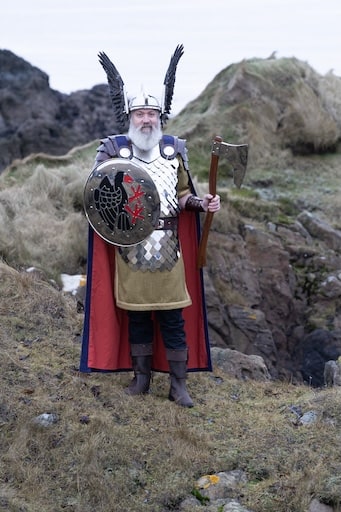Copyright © 2009 - 2025 Up Helly Aa Committee
Saga of Eystein Magnusson
King Eystein Magnusson
Eystein Magnusson ruled Norway as joint king together with his two brothers, Sigurd and Olaf. The kingdom was divided between the three of them in 1103 after the death of their father, King Magnus Barelegs. They made no formal boundaries, but Eystein tended to spend his time up north and out to the west of the country. He was keen to form connections with the influential elite of Norway and to this end married Ingebjørg who belonged to a prominent noble family in Gudbrandsdalen.
Eystein was wise and generous and as such had lots of friends. One of these was a poet from Iceland called Ivar Ingimundarson who was hopelessly and inconsolably in love with a girl back home. Eystein could see that his friend was not his usual cheery self, so each day he took time to listen and talk with Ivar about his woes and before long he was back to normal as jovial as ever.
In 1107 Sigurd set sail on a crusade to the Holy Land with a large fleet, leaving Eystein and Olaf to rule the country. During this time Magnus Erlendsson arrived from Orkney claiming that his cousin, Hakon Paulsson, refused to share the isles with him as their fathers had done previously. He met with Eystein who duly confirmed his legitimate right granting him the title of earl and half the earldom, the half that included Shetland.
When Sigurd returned to Norway in 1110 the three brothers went back to sharing rule as before. Sigurd bragged about all the things he had seen and done while he was away. Eystein wasn’t that impressed and questioned what good any of it had done for the prospects of their kingdom and reminded his brother of how he had totally overhauled the country’s infrastructure during his absence. Eystein had pursued a number of vital construction projects while Sigurd had been sunning himself in the Mediterranean.
Eystein noted an increase in the amount of cod being fished in the north of the country to keep up with the high demand on the continent. In response he developed Bergen harbour and established it as the main port for international export. To improve trade he made further developments from Bergen up the coast to the fishing centre at Vågan in Lofoten. He designed a new harbour at Agdenes on the mouth of Trondheimsfjord, a stratagem to secure the sea highway northwards. It’s said that this port was at the time to be among the most advanced in Europe. Eystein also built several large dry-docks at Trondheim where he had his own galley built, a dragon ship resplendent with a golden head and tail.
Olaf died of a sudden illness in 1115. Eystein and Sigurd continued to rule together until 1123 when, during a feast in August of that year, Eystein also fell ill and died. His body was carried from Hustad in the west of the country north to Trondheim and buried in the cathedral.
By Brydon Leslie
